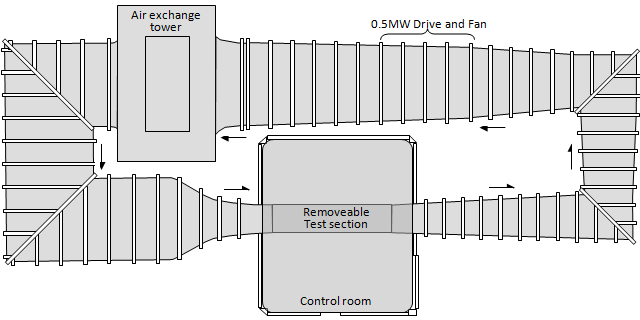Stability wind tunnel description
Stability Wind Tunnel Description
The Stability Wind Tunnel at Virginia Tech is one of the largest university operated wind tunnels in the United States. In addition to its size, the flow quality is remarkable making it a prime research facility. It consists of a continuous, single return, subsonic wind tunnel with 7.3-m long removable rectangular test sections of square cross section 1.83 m on edge. The general design layout is illustrated in Figure 4. The tunnel is powered by a 0.45-MW variable speed DC motor driving a 4.3-m propeller at up to 600 RPM. This provides a maximum speed in the test section (with no blockage) of about 80 m/s and a Reynolds number per meter of up to about 5,000,000. The tunnel forms a closed loop, but has an air exchange tower open to the atmosphere to allow for temperature stabilization. The air exchange tower is located downstream of the fan and motor assemblies. Downstream of the tower, the flow is directed into a 5.5x5.5-m settling chamber containing seven turbulence-reducing screens. Flow exits this chamber through the 9:1 contraction nozzle, which further reduces turbulence levels and accelerates the flow to test speed.
Tunnel speed is regulated by a custom designed Emerson VIP ES-6600 SCR Drive which could be interfaced with the tunnel's computer data acquisition system. This drive system is a state of the art wind tunnel control which not only provides for efficient operation but more precise speed regulation than is possible with older style d.c. generator drives commonly found in tunnels of similar size. The precisely regulated d.c. power source eliminates all the cyclic unsteadiness in tunnel velocities normally associated with older tunnel drive systems as well as the turbulence inducing vibrations inherent with such drive systems.



